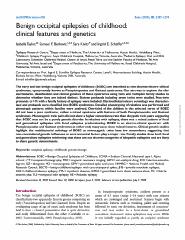Please use this identifier to cite or link to this item:
https://ahro.austin.org.au/austinjspui/handle/1/10650| Title: | Benign occipital epilepsies of childhood: clinical features and genetics. | Austin Authors: | Taylor, Isabella;Berkovic, Samuel F ;Kivity, Sara;Scheffer, Ingrid E | Affiliation: | Department of Medicine, Epilepsy Research CentreThe University of Melbourne, Austin Health, Heidelberg West, Victoria, Australia | Issue Date: | 9-Jul-2008 | Publication information: | Brain : A Journal of Neurology 2008; 131(Pt 9): 2287-94 | Abstract: | The early and late benign occipital epilepsies of childhood (BOEC) are described as two discrete electro-clinical syndromes, eponymously known as Panayiotopoulos and Gastaut syndromes. Our aim was to explore the clinical features, classification and clinical genetics of these syndromes using twin and multiplex family studies to determine whether they are indeed distinct. Sixteen probands including seven twins were studied. Non-twin probands (n = 9) with a family history of epilepsy were included. Electroclinical seizure semiology was characterized and probands were classified into BOEC syndromes. Detailed phenotyping of relatives was performed and phenotypic patterns within families were analysed. One-third of the children in this selected series of BOEC did not have a pure syndrome, rather a mixed syndrome with features of both Panayiotopoulos and Gastaut syndromes. Monozygotic twin pairs did not show a higher concordance rate than dizygotic twin pairs suggesting that BOEC may not be a purely genetic disorder. In relatives with epilepsy, there was a mixed pattern of focal and generalized epilepsies with focal epilepsies predominating. BOEC is an electro-clinical spectrum with Panayiotopoulos and Gastaut syndromes at either end; many cases show mixed features. Clinical genetic studies highlight the multifactorial aetiology of BOEC as monozygotic twins have low concordance suggesting that non-conventional genetic influences or environmental factors play a major role. Family studies show both focal and generalized epilepsies reinforcing that these are not discrete categories of idiopathic epilepsies and are likely to share genetic determinants. | Gov't Doc #: | 18669497 | URI: | https://ahro.austin.org.au/austinjspui/handle/1/10650 | DOI: | 10.1093/brain/awn138 | Journal: | Brain | URL: | https://pubmed.ncbi.nlm.nih.gov/18669497 | Type: | Journal Article | Subjects: | Adolescent Child Child, Preschool Diagnosis, Differential Diseases in Twins Electroencephalography Epilepsies, Partial.diagnosis.genetics.physiopathology Humans Infant Occipital Lobe.physiopathology Pedigree Phenotype Seizures, Febrile.genetics Syndrome |
| Appears in Collections: | Journal articles |
Files in This Item:
| File | Description | Size | Format | |
|---|---|---|---|---|
| 18669497.pdf | 284.31 kB | Adobe PDF |  View/Open |
Page view(s)
34
checked on Dec 21, 2024
Download(s)
126
checked on Dec 21, 2024
Google ScholarTM
Check
Items in AHRO are protected by copyright, with all rights reserved, unless otherwise indicated.
